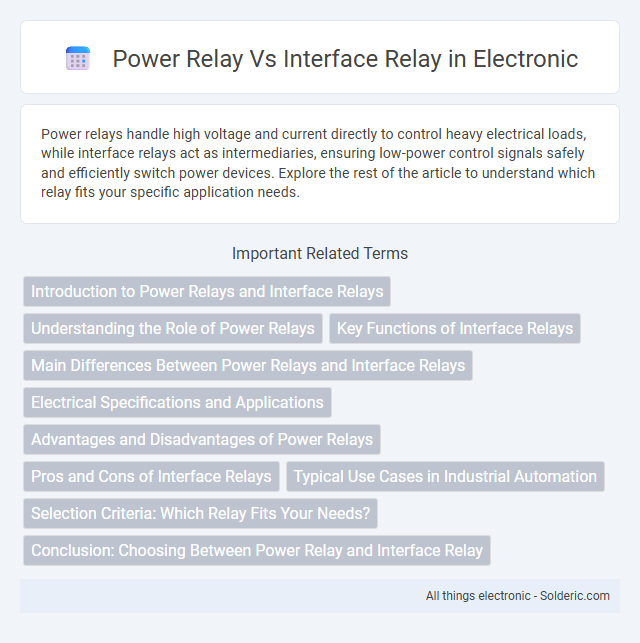Power relays handle high voltage and current directly to control heavy electrical loads, while interface relays act as intermediaries, ensuring low-power control signals safely and efficiently switch power devices. Explore the rest of the article to understand which relay fits your specific application needs.
Comparison Table
| Feature | Power Relay | Interface Relay |
|---|---|---|
| Function | Switches high power loads | Connects control circuits to power devices |
| Load Capacity | High (up to several hundred amps) | Low to medium (typically below 10A) |
| Application | Motor control, lighting, heavy machinery | Signal isolation, PLCs, automation controls |
| Coil Voltage | Wide range (12V to 240V AC/DC) | Usually low voltage (5V to 24V DC) |
| Contact Type | Normally open (NO), normally closed (NC), multiple contacts | Primarily NO, some NC |
| Size | Larger due to heavy-duty components | Compact and lightweight |
| Switching Speed | Slower due to mechanical contacts | Faster for control signals |
| Isolation | Electrical isolation between coil and load | Electrical isolation between control and power circuits |
| Cost | Higher due to robust design | Lower, optimized for control applications |
Introduction to Power Relays and Interface Relays
Power relays are electromechanical devices designed to switch high voltage and current loads, commonly used in industrial automation and motor control applications. Interface relays serve as low-power intermediaries that safely connect control circuits to higher power sections, providing electrical isolation and signal amplification. Understanding the distinction between these relays helps ensure your control system maintains optimal performance and protection.
Understanding the Role of Power Relays
Power relays serve as electrically operated switches designed to control high-current circuits by isolating control signals from the heavy power load, ensuring safe operation in industrial equipment. Unlike interface relays, which primarily manage low-power signal switching for communication between control systems and devices, power relays can handle higher voltage and current levels, making them essential for controlling motors, heating devices, and lighting systems. Their robust construction and capability to switch large loads reliably make power relays critical components in power distribution and automation systems.
Key Functions of Interface Relays
Interface relays serve as critical intermediaries that connect low-power control circuits to high-power devices, enabling safe signal transmission and electrical isolation. They provide essential functions such as voltage conversion, signal amplification, and protection against electrical noise and surges. Your system's reliability improves significantly when interface relays manage these tasks, ensuring seamless communication between different circuit components.
Main Differences Between Power Relays and Interface Relays
Power relays handle higher voltage and current loads, typically used for switching motors, heaters, and large electrical devices, while interface relays control lower-power signals for communication between control circuits and field devices. Power relays often feature heavy-duty contacts and robust construction to manage high power, whereas interface relays focus on electrical isolation and signal amplification to protect sensitive equipment. Understanding your system's load and control requirements helps determine whether a power relay or an interface relay best suits your application.
Electrical Specifications and Applications
Power relays are designed to handle high voltage and current loads, typically rated from 10A to over 100A, making them suitable for controlling motors, heating elements, and industrial machinery. Interface relays operate at lower electrical ratings, often below 10A, and serve as signal isolators or logic interfaces between low-power control circuits and high-power devices. Your choice between these relays depends on the specific electrical requirements and the necessity for isolation or amplification in the application.
Advantages and Disadvantages of Power Relays
Power relays offer high current capacity and strong electrical isolation, making them ideal for controlling heavy-duty electrical equipment. Their fast switching and durability benefit industrial automation but often come with larger size and higher coil power consumption. However, power relays can produce electrical noise and mechanical wear over time, which may limit their lifespan in high-frequency switching applications.
Pros and Cons of Interface Relays
Interface relays provide electrical isolation between control circuits and high-power devices, enhancing system safety and protecting sensitive components from voltage spikes. Their compact size and fast switching capabilities make them ideal for signal-level applications, though they typically handle lower current loads compared to power relays. You should consider the limited current capacity and potentially higher cost of interface relays when designing systems that require robust power switching.
Typical Use Cases in Industrial Automation
Power relays are primarily used for switching high-current loads such as motors, heaters, and lighting systems in industrial automation, ensuring reliable control of heavy electrical equipment. Interface relays serve as intermediaries between low-power control circuits and high-power devices, protecting sensitive PLC inputs or controllers from voltage spikes and ensuring safe signal transmission. Both types of relays are essential in automation systems, with power relays managing load switching and interface relays enabling safe communication between control and power elements.
Selection Criteria: Which Relay Fits Your Needs?
Power relays are designed for switching high current loads and are ideal for applications requiring robust performance and durability, such as motor control or industrial machinery. Interface relays provide electrical isolation and signal adaptation between low-voltage control circuits and higher voltage loads, making them suitable for sensitive or mixed-voltage systems. When selecting a relay, consider factors like load current, voltage requirements, isolation needs, and the control signal type to ensure the relay fits your specific application demands.
Conclusion: Choosing Between Power Relay and Interface Relay
Power relays are ideal for switching high currents and voltages in industrial applications, while interface relays excel in signal-level control and isolation between circuits. Your choice depends on the electrical load and the need for precise control or heavy-duty switching. Selecting the right relay ensures optimal performance, safety, and longevity of your electrical system.
power relay vs interface relay Infographic

 solderic.com
solderic.com